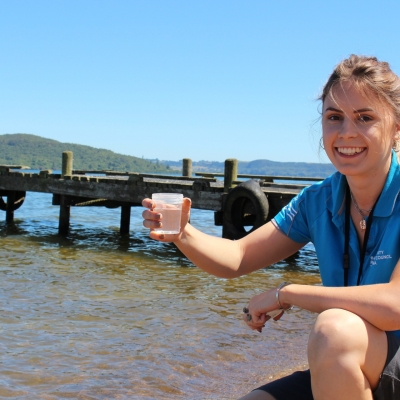
9 January 2018
Gemma Kerrisk has been checking the Rotorua Lakes this summer to make sure they are safe to swim in.
While you’ve been enjoying a dip in one of the region’s lakes this summer, Gemma Kerrisk has been checking they’re safe to swim in.
The Bay of Plenty Regional Council (BOPRC) algal monitoring technician will continue to spend the summer taking samples from lakes Okaro, Rotoehu, Rotorua, Rotoiti and Tarawera and in the laboratory behind a microscope, analysing the samples to make sure the lakes are safe for swimming.
For Kerrisk, knowing that she’s helping to provide safety information to those out enjoying the environment is the most enjoyable aspect of the job.
She knows the work she and the team are doing is crucial to making sure those enjoying the region’s lakes have the most up to date information on the health of the water they are in contact with.
Kerrisk, who holds a Bachelor of Science with a major in genetics, followed by a postgraduate Diploma in Science with a major in environmental management, has been trained by senior scientists to identify algae as part of the role this past month.
While four days a week are spent behind the microscope using the skills learnt at university to analyse the samples, she manages to get out in the environment once a week to sample the lakes.
Between November and May, she collects samples from 13 sites in the Rotorua area each week. The frequency can change depending on the health status of the lakes – and sites with blooms may be tested in more places and more frequently.
Testing is carried out on both the water and the algae. Using a microscope Kerrisk counts the cells of cyanobacterial (blue-green algae) colonies and then calculates the overall volume.
If there are too many of the potentially toxic cells, an alert is sent to all the relevant authorities and Toi Te Ora Public Health issues a warning to the public.
Kerrisk says the results are usually published within 24 hours on BOPRC’s and the Rotorua Te Arawa Lakes Programme’s website and graded according to Ministry for the Environment’s New Zealand Guidelines for Cyanobacteria in Recreational Fresh Waters. Green is safe, with red considered a potential health risk, and the level at which a public health warning is usually issued once breached.
“An amber or orange grading is a warning that elevated levels have been detected, and extra monitoring is being done to check if a health warning is needed.”
She says in some cases, the testing can give early indication of a potential bloom when results are compared to past results.
“Combine this with forecast weather conditions and you can get an idea of what sites may bloom in the coming weeks.”
Kerrisk says she loves using her molecular and microbiology skills to ensure the environment is a safe place that communities can enjoy.
“I am very passionate about the environment and being able to enjoy what nature has to offer.”
To check out the health of the region’s waterways, go to www.boprc.govt.nz/our-region-and-environment/water/swimming-water-quality/ or visit https://www.rotorualakes.co.nz/cyanobacteria-lake-monitoring